
Please find on these pages obituaries of Old Paulines who left the school between 1940-49.
Martin J Bradley
(1945-47)
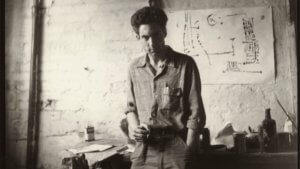
Martin Bradley was an intrepid and multilingual artist known as the ‘Rimbaud of Soho’ whose strange career included work on a cargo ship and desertion from the Spanish Foreign Legion.
Born in Hammersmith in 1931, Bradley’s unmarried parents (a Flemish mother and army captain father) gave him up for adoption, and he ended up in an orphanage.
Against the wishes of an anonymous benefactor who had paid his school fees, at the age of 14 Bradley joined a cargo ship as a cabin boy. The destination was South America.
Drawing his fellow seamen during the long Atlantic crossings meant that by 1949, he was selling portraits to the men he found in Seamen’s Missions after returning to London. At 19, he became an abstract painter, enjoying the carousing camaraderie of Soho’s artistic scene.
Despite a solo exhibition and interest from London dealers, Bradley, a fluent French speaker, chose to live in Paris. It was here that the influential proprietor of the Galerie Rive Gauche introduced his work to an international audience. However, Bradley fell into a state of advanced alcoholism; a fellow artist forced him to return to a sanatorium in England. Bradley believed this intervention saved his life.
In 1961, Bradley joined the Spanish Foreign Legion, became the company tattooist and briefly saw action in the Sahara. Deserting after less than two years, he travelled extensively in Asia where he became fluent in Chinese, Japanese, Tibetan and Hindi.
Around this time, Bradley wrote: “I want to share with you, the spectators, the marvellous moments that allow us to reflect on the Eternity of the Cosmos. I consider myself rather a ‘visual poet’ than a painter and it is thus that I express myself.”
In 1951, Bradley married Joan Rix. They had two children, Francis and Juanita. In Japan, he met his second wife, Tatsuko, and they married in 1975. Bradley converted to Buddhism and concentrated on translating ancient texts into English.
With more than 130 solo exhibitions, Bradley’s eclectic work has been collected worldwide, including by fellow artists Barbara Hepworth and Roland Penrose. Martin Bradley died in April 2023.
Adapted from the obituary published in The Times on 19 January 2024
David J Cakebread (1942-45)
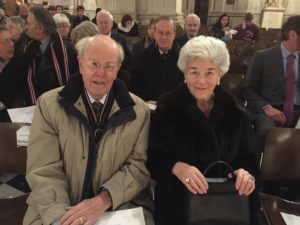
David James Cakebread was born in Ealing to Gordon and Agnes; a stockbroker and housewife. He had an older brother John Robert Gordon (1936-39) who served in the RAF in Bomber Command as a navigator and wireless operator during World War 2.
David’s prep school was Durston House in Ealing before he arrived at St Paul’s.
Following National Service in the RAF, David studied to become a member of the Institute of Taxation in 1961 and a Fellow of the Institution of Chartered Accountants in 1963. He joined T Backshell and Company and later became a partner of Pitman Cakebread & Co.
He met the love of his life Audrey Dunn in 1950 and they married on 30th April 1955 in Ealing. They had two sons Terry Michael John (born 1957) and Peter Graham (born 1959)
In the early 1980s, David became a part time Director of Crouch Group and in 1982 David and Audrey went to live and work in Florida for a couple of years where he worked on a large property development for Crouch.
He was President of the Old Pauline Club in 1989 and attended Old Pauline events at the Worshipful Company of Mercers, the Guildhall and St Paul’s Cathedral when in January 2015 he was the oldest past president present.
David enjoyed golf and used to play at Ealing Golf Club on Sundays. He played with many people from Round Table (later Rotary) and when in 1984 he moved to West Sussex David joined Ham Manor Golf Club where he became captain in 1999. He enjoyed playing bridge regularly, going to the theatre and caring for local wildlife.
Sadly, David’s wife Audrey died about a month after him. David is survived by his two sons and two granddaughters.
David was a very kind and generous man, always fun to be around and caring of others. A true gentleman: he will be greatly missed.
Written by: The Cakebread family
Richard J (‘Jim’) Cook (1944-49)
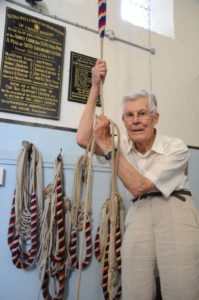
Richard James (‘Jim’) Cook died on January 9th, 2020, aged 89.
Jim was a wartime boarder and a peacetime day-boy from Ealing who enjoyed school greatly, though he only attended his first alumnae gathering in his 80’s. I once asked him if he had been a good student: “Well, I aimed to come top in most subjects” was his rather cocky reply! He won a scholarship in Chemistry to Oxford, where he pursued his passion for rowing (at which he had, of course, excelled at school and was Captain of Boats in 1949). His other passion, bell ringing, developed not at school but at his local church, and it endured long after his rowing days were done. Jim met his wife, Betty Willcox, in a belfry: she came up to Oxford having just read ‘The Nine Taylors’ by D.L. Sayers, and thought ringing sounded romantic!
Jim narrowly missed a first, and then narrowly missed death during National Service with the Royal Artillery. After a day on the ranges, their 3-tonner tipped over on a curve. Waking up in Hexham hospital, Jim knew that he’d been spared: every day thereafter was a gift from God.
Fully recovered, and soon married, Jim worked as a research chemist with ‘Morgan Crucible’, developing carbon electric brushes. Jim transferred to sales in 1978, taking on E. Europe. Long trips abroad engaged his loves for travel, history, geography, languages and getting into scrapes. Asking directions from a passer-by in Bucharest one day led to a 40-year connection with a Romanian defector in Brussels, a pianist who had fled without his vast collection of manuscripts. The ‘Jim Cook Library’ is soon to open in Brussels, consisting of all the manuscripts that he patiently smuggled out after each trip to Romania.
Four children were welcomed and well educated (though not at St Paul’s!) Eleven grandchildren lit up his retirement, as did travelling with Betty, voluntary work with Churches, NADFAS, Twinning Associations, rowing reunions and, of course, bell-ringing. After Betty’s death in 2015, ringing was a source of fellowship, stimulation and solace, even after a broken back and a heart condition made climbing to the bell-chambers a challenge (especially to the nerves of his fellow-ringers!) After an uncomfortable year of illness, Jim died very quickly. His life, and the God he had served, were confidently celebrated with affectionate tributes and a quarter-peal (half-muffled) of Stedman Triples. As a clerical admirer posted on Facebook, “May he rest in peace, and may the glory in which he rises be accompanied by the joyful noise of ringing bells.”
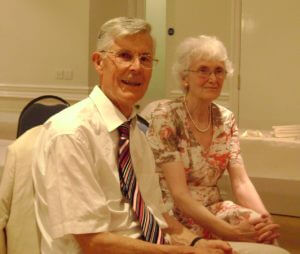
Written by: Alan Cook, son
Alexander Robert Rankin Eason (1943-47), 27 June 1929 – 16 April 2021
Alexander (Alec) Eason was born in Poona India in 1929 where his parents were a publisher with the Colonial Office and missionary nurse. He came to England at the age of two. The family home in Horley was bombed during WWII so he was evacuated to Auchterarder, to live with his grandparents, later attending St Paul’s School in Crowthorne during the war. Alec truly valued his education, his housemaster Mr Cook was a huge influence in his life. He completed his national service in Greece and Cyprus, before proceeding to St Andrews University to study medicine. He excelled at all sports, playing rugby for Scottish Exiles, St Paul’s first XV and as captain of St Andrews First XV and Scotland B Team.
After graduation, Alec held house positions at the Southern General Hospital and the Royal Maternity Hospital in Glasgow, where he became expert in exchange-transfusions of new-borns. He also joined the Territorial Army as a Medical Officer. In 1960, he married Catherine Wilson, a nurse, enjoying over sixty years of marriage together. They initially spent two years in Sleights in the Yorkshire Dales as a GP before he established himself in general-practice in Kirkintilloch for the remainder of his career.
Alec was an exceptional doctor; each day before his morning clinic he conducted rounds at Broomhill Hospital supervising the care of the chronic young who became long-term and elderly patients; he showed great care and empathy in his practice, conducted house-calls at all hours, and provided not only expert medical care but also counsel and support to help patients deal with the local authorities. His greatest joy was delivering babies at home, which led to additional happiness as he took medical care of these children as they proceeded through school to adulthood. Many young doctors trained with Alec and his knowledge, wide experience and common sense made a huge impact on them.
Alec loved gardening and restoring their holiday home in Machrie on the Island of Arran. In his retirement he took up painting through classes at the Glasgow School of Art. He read The Telegraph every day and had a very broad knowledge across politics, current affairs, art and literature.
Alec Eason was an extremely generous, highly principled doctor who provided the highest quality of medical care to generations of citizens of Kirkintilloch and surrounding areas. A much loved family man he is survived by Cath, his children Fiona, Craig, and Alistair and seven grandchildren 3 in Scotland, 2 in England and 2 in Canada.
Written by: Eason and McDougall Family Contributions
Ralph Rudolph Mathias Ehrmann (1939-40), 8 March 1925 – 10 January 2023
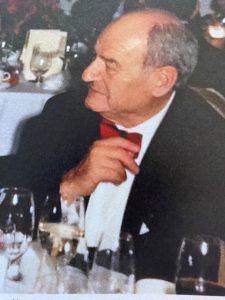
Ralph was born in 1925 in Leipzig, into the German-Jewish mercantile haute bourgeoisie. With the rise of Nazism, the family moved to London in 1933 and became British citizens in 1939.
He attended St Paul’s for a relatively short time (1939-40), joining his elder brother Gus, and completing his Metric at the young age of 15. Of note was being evacuated, with the whole school, to Crowthorne near Wokingham when war broke out.
He completed his studies before volunteering to join the RAF at the age of 18 in 1943. “Airman Ehrmann” trained as a bomb aimer-navigator only for his aircraft to crash on its last training flight in 1944.
After eventually being demobbed, he worked with SG Warburg Merchant Bank where his speciality was turning around manufacturing companies. This eventually took him to Airfix, a struggling plastics company, where he suggested that the company should diversify into making modelling kits using the new plastic polystyrene imported from America.
These Airfix kits were a huge success and Ralph soon found himself in the public eye as the face of the toy industry. At its peak in the late 1960s and 1970s, he served as chairman of the British Toys and Hobbies Association.
After almost 30 years at Airfix, Ralph and his wife Inge moved to the US where he ran a small conglomerate Clabir. Following retirement form Clabir and the arrival of grandchildren, Ralph and Inge were drawn back to the UK, returning to Kensington where the family home had been.
He remained active, spending time at the Institute of Directors as a mentor to young entrepreneurs, collecting modern art and chasing after his grandchildren.
Ralph was married to Inge in 1955. She had lived in South Africa since the 1930s and, like him, had been born in Germany. Their happy and fulfilling partnership lasted 66 years and both were devoted to their children, Philip, Helen, and Alexandra – all attending St Paul’s – and their grandchildren. He and Inge bore the tragedy of the loss of their daughter Helen (married to Simon Rooms) to cancer in 1997 with a fortitude that belied the deep sorrow they felt.
The above has been largely abridged from my father’s obituary in the Times, 30 January 2023. Suffice to say, “going home” presents from my and my sister’s birthday parties were pretty special!
Written by: Philip Ehrmann (1972-77)
John Anthony Fernandez (1937-41), 1923-2017
Tony Fernandez was born in London in October 1923 to his parents Dr. Thomas Fernandez and Eleanor Christian Lilian Fernandez (nee Mayo).
He grew up at the family home in Chiswick, London and went to St. Paul’s school in 1937. He was evacuated to Crowthorne in 1939 when the war started, where the school was allocated some of Wellington College’s schoolrooms and grounds. He finished his school there in 1941. He stayed at one of the teachers’ houses during his time at Crowthorne, called Mr. R.E.D. Brown. He remembered going by bicycle at the beginning and end of the term from Chiswick to Crowthorne, a distance of 35 miles. On one occasion he remembered being “chased” by a V1 flying bomb on his bicycle.
He attended Trinity College, Cambridge from 1941 – 1942, studying engineering and economics, but left Cambridge university before completing his degree, as so many others did during the Second World War. He joined the Admiralty where he used his engineering background to work on the gunnery control systems of large capital ships like HMS Rodney. His father died in 1945 and Tony decided to stay in London with his Mother rather than go back to Cambridge, so he went to University College of London to finish his engineering degree. He went on to complete a masters degree in structural concrete engineering in 1949.
Tony and June met in 1946 at Honeybourne, a harvest camp for students set up after the war when labour was in short supply to harvest the crops. The camps were mainly in former army camps and the students were housed and fed in exchange for their work. Fortunately, they were both students at London University and both lived in West London, so they were able to see each other regularly after leaving Honeybourne. They married in 1949 – a marriage which lasted 68 years. They had three children – Patricia, Paul and Theresa.
From 1949 until 1952 Tony worked for Richard Costain. One of his projects was helping to build the landing stage at Battersea for the Festival of Britain in 1951.
Then he got a job with the Colonial Office as chief engineer in Port of Spain, Trinidad in charge of works and hydraulics. At that time Trinidad was a British colony.
He returned to the UK in 1954 when he joined Alcan. He worked in their UK office until 1959 when he moved to Portugal as manager of their Lisbon office. Then he was transferred to Oporto where he opened an office in 1961. Alcan wanted to send Tony to Mozambique after his assignment in Portugal, but he decided to return to England.
He joined Monsanto in 1963, the chemical engineering company, and worked for a subsidiary called Jablo, makers of laminated plastics including polystyrene, an excellent insulating material. He left Jablo to set up his own company called Lowkay Engineering and took out a patent for his invention of using polystyrene shuttering for single span bridges.
Tony loved playing tennis all his life. As a young man he joined the local tennis club in Chiswick and Queen’s Club and then became a member of Hurlingham in 1956. His love of tennis continued in Portugal both in Estoril and Oporto. In 1963 Tony and June made a clean sweep of the tennis trophies in the Oporto British Cricket & Lawn Tennis Club. When Tony retired he and June moved to the south of France to a small village called Hyeres near Toulon. He discovered the International Veterans’ Circuit and played in tournaments in England, Spain, France, Italy and Germany. In April 2000 Tony won the men’s 75+ singles title at Alassio. In 2003 he was invited to play for the Great Britain Veteran’s Team at the tournament in Turkey. Then on 15th August 2004 at the British Veterans Tournament in Aorangi Park, Wimbledon, he won the Men’s 80 plus Doubles title with Bob Caruana. This was the year when he achieved his highest world ranking of 24 for his age group.
When Tony and June returned to England in 2004, they bought a flat in Kingston where they have lived since then. Hurlingham was a major part of his life during these years. He played tennis and latterly took up bowls. He enjoyed watching the cricket and also went to the French conversation group.
Tony is survived by his wife June, and by his three children Patricia, Paul and Theresa. He has five grandchildren and three great grandchildren. He remained active right up until the end, continuing to drive his car. He was at home up until the last evening when he had a heart attack and was admitted to Kingston hospital where he sadly passed away. He will be missed enormously by all who knew him but especially by his loving family.
John R D (Denis) Gildea (1938-42)
Denis Gildea, at St Paul’s School from 1938-1942, died in July 2018 aged 94. He played a key role in negotiating Britain’s trade treaties after the Second World War.
Denis was born in Worthing, West Sussex, the only son of Rudolf, a rubber planter, and his wife, Rosalind (nee Jepson). With his father working in the Far East, his parents lived mostly apart, and in 1934 his mother took him to Barcelona and Mahon, where he was educated in Spanish schools. Returning to the UK in 1935, he attended Colet Court and then St Paul’s school during the periods of wartime evacuation.
Having won a £50 exhibition to Worcester College Oxford to read Greats, he joined the Royal Navy in the Second World War, escorting convoys across the Atlantic as a sub-lieutenant. His mother died of cancer during the war and his father, captured by the Japanese, died in Changi internment camp in Singapore in 1945.
Demobbed, he turned his back on Classics and took a degree in the then pioneering combination of philosophy, politics and economics at Worcester College, Oxford under Asa Briggs. He spent his holidays with a Belgian family to add French to his Spanish, as his sense of the importance of internationalism to world peace grew. In retirement he even added Russian to his range of modern languages!
As a senior civil servant in the Board of Trade he took part in negotiations to integrate Europe into the Marshall Plan through the Organisation for European Economic Cooperation. He also helped to develop the General Agreement on Tariffs and Trade and to construct the Efta free trade area, and worked with Edward Heath and George Brown in the 1960s to bring Britain into the European Economic Community. Later, under Margaret Thatcher’s second government, he was tasked with privatising British Airways.
In his 2002 memoirs, he wrote that when he retired from the civil service in 1983: “I thought our generation … had done better than our fathers in creating a better world after the war. Indeed we should look back on the 30 or so years after the war as a sort of golden age.”
In his later years he suffered from Alzheimer’s but was not beyond calling Brexit “a rather silly idea”.
He is survived by five children, 17 grandchildren and three great-grandchildren.
Written by: Edward Gildea, son
Thomas J (Tom) Gilbert TD MSc DIC CEng FIChemE (1945-48)
My father, Tom, who has died aged 90, was at St Paul’s immediately after the Second World War, after wartime evacuation to Keswick. He rowed in the 1947 First VIII, “The Champions of The Tideway”. Having represented the school at Henley Royal Regatta, for the next 70 years he was a familiar sight in the Stewards’ Enclosure, wearing his School Colours Cap.
After St Paul’s he studied Chemical Engineering at Imperial College, where he maintained his passion for rowing, staying on for an MSc. He joined the Institution of Chemical Engineers in 1949, was Chartered in 1960 and elected a Fellow in 1974.
He did National Service in the Royal Electrical and Mechanical Engineers in 1954/5, continuing as an officer in the Territorial Army until the early 1960s, commanding his Light Armoured Workshop during annual exercises in Germany. He was awarded the Territorial Decoration.
He met his wife, Judy, while working for ICI on Teeside. They married in 1964. After five years in Great Ayton, North Yorkshire, they moved to Rickmansworth, on the outskirts of London, living in the same home for over 50 years.
His engineering career saw him managing a variety of projects for companies that included Power Gas, Pritchard Rhodes, Bechtel and Norsk-Hydro. Some of these took him abroad (unaccompanied), to Indonesia, Saudi Arabia and Norway.
A passion he shared with Judy was classical music, especially the Piano, and the Opera. A chess set was always at hand for a visit of son or grandson. He loved reading, especially books about Churchill and Field Marshal Montgomery.
He had the ability to form lasting friendships and enjoyed the opportunity of retirement to strengthen these relationships. Thoughtful and kind, he was always encouraging, displaying his natural geniality and enthusiasm for life.
Tom died on 9 December 2019 with his family by his side. He is survived by his wife, Judy, children Peter, Penny and Jo, and six grandchildren.
Submitted by Commander Peter Gilbert Royal Navy (son)
Gilbert W Green (1924-2020)
Gilbert attended St Paul’s before war broke out and was evacuated with the school in 1939. In 1940 the family home in Middlesex was bombed and the school became his only home. He remembers camping out in a scout hut with his father acting as a fire-watcher in the holidays. He was exempted from immediate military service and went to St John’s College, Cambridge in 1942, specialising in geology. After the war he joined the Geological Survey of Great Britain, which became his career for nearly 40 years.
In 1950 Gilbert married Julian Quick, daughter of the theologian Canon Oliver Chase Quick (1885-1944). Their four sons all attended the School: Robert (1965-70), Christopher (Hilary) (1967-72), Matthew (1971-75) and Richard (1973-1977). The family moved to Ealing in 1958 and stayed there until the Survey relocated to Nottingham in 1979.
Gilbert loved his career in geology, which included a secondment to the geological Survey of Jamaica in 1968-71. He was never happier than when in the field mapping, mainly in Somerset and South Wales. His children joined him in the summer holidays, living in a caravan. No foreign holidays for them – but he did his best to pass on to them his passion for the countryside and nature.
Gilbert was a deeply committed Anglican, becoming churchwarden in several parishes, devoting the same energy and commitment to this as to all he did. On at least one occasion he went back to his old school to speak at the Christian Union.
By the 1980s Gilbert’s job had moved from field work to management, and he found that much of the joy of it was lost. He surprised many by developing a passion for forestry and buying Biss Wood, outside Trowbridge in Wiltshire. He and Julian moved nearby in 1983, eventually settling in the village of Edington. He applied himself with a will to developing the wood, which is now a nature reserve.
Gilbert lost Julian in 2009, and his last years saw a gradual decline in eyesight, hearing and mobility. He managed to stay in his home until his death, largely thanks to his son Richard, who was his companion in his final years.
Written by: The Green Family
Henry Jackson (1943-1948) (previously known as Henry Isaacsohn)
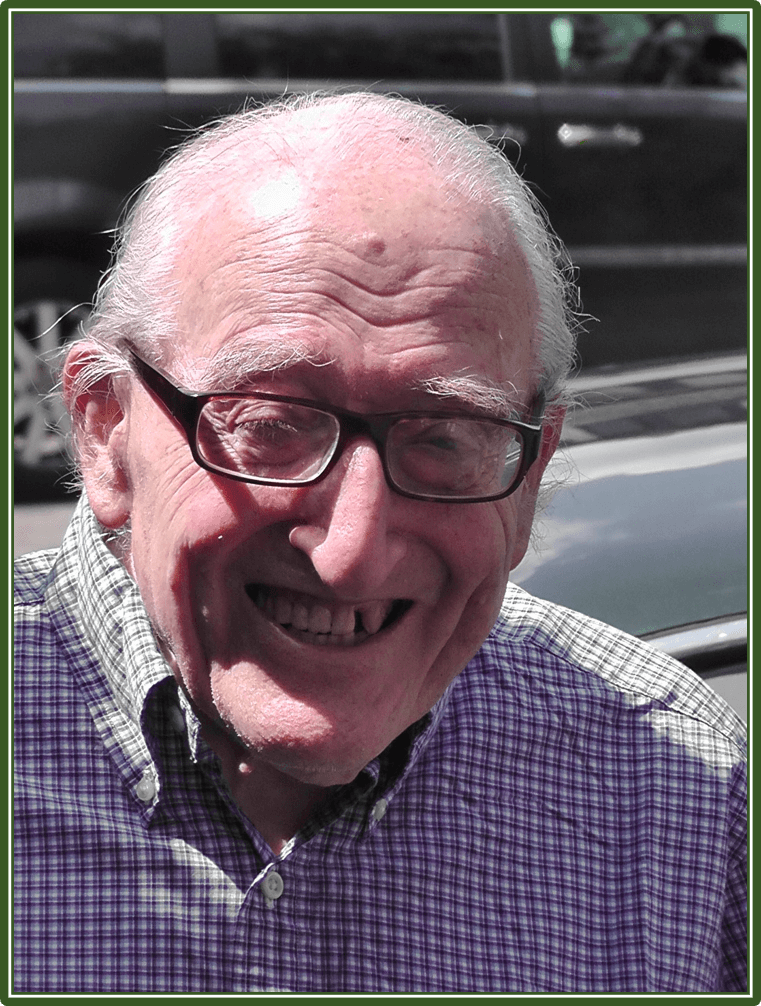
Henry Jackson (born ‘Heinz Josef Isaacsohn’) loved his time at St Paul’s School. He found it particularly appropriate to celebrate his 90th birthday last year at its former Hammersmith premises (now a hotel); and, even on his deathbed, repeated with enthusiasm that his days at St Paul’s remained among the happiest of his life.
Perhaps his schooldays also represented a time of stability for the young Henry when compared with the tumultuous historical background that he and his family had previously experienced.
Henry was born in Berlin on 9 November 1929. His parents were Jewish. Within four years of his birth, Hitler had come to power and life for German Jews became increasingly impossible. In that sense, Germany had been an unfortunate choice of destination for his Russian mother, who had fled that country shortly after the Revolution, at which time she had witnessed her two elder brothers leaving the politically divided family home to fight for the Tsar and the Bolsheviks respectively. She met her husband Oscar in Berlin and Henry was their only child.
Henry’s early childhood was spent under the Nazi regime. His earliest memories included seeing torchlit Hitler Youth parades and not understanding why he could not join in; as well as experiencing his father being arrested and taken to Sachsenhausen concentration camp on the night of his ninth birthday on 9 November 1938 – Kristallnacht.
Henry was lucky. His mother was able to negotiate his father’s release from Sachsenhausen in part because the local Gestapo did not think that she was Jewish as a result of her blonde hair and blue eyes.
He was luckier still when he and his parents managed somehow to leave Germany on one of the last flights out of Berlin for Amsterdam, before leaving The Netherlands a few days later on the last boat to England before war broke out on 1 September 1939.
Henry remained painfully aware that millions of others were not as lucky. That included his uncle Alfred and aunt Edith, both of whom were murdered at Theresienstadt concentration camp; and their son, his first cousin Hansi, of whom he was particularly fond, who was murdered at Mauthausen concentration camp just days before the end of the war, having previously been transferred from Theresienstadt and Auschwitz.
Henry’s Nazi past underpinned and shaped him for the rest of his life, retaining a strong hatred of injustice and a huge gratitude to Britain throughout. He left those feelings indelibly printed on subsequent generations, with it not being any coincidence that his only child has ended up happily and passionately working for the past two decades at two international courts (the European Court of Human Rights and the International Criminal Court) that were established as a direct result of the Holocaust and the Nuremberg Tribunal respectively.
Henry remained grateful that he was able to live a full and happy life for a further 80 years after the outbreak of the Second World War. After arriving in England, he quickly overcame linguistic difficulties to enjoy his time at The Hall School, Hampstead. He was then delighted to arrive at St Paul’s, where he was evacuated to Crowthorne during the war before returning to its Hammersmith premises thereafter. He was particularly impressed by the fact that those premises had, during the war, been used by General Montgomery to plan the Normandy (“D Day”) landings and to present the final invasion plan to General Eisenhower, Winston Churchill and King George VI on 15 May 1944. Indeed, he described how much he enjoyed a talk that General Montgomery – himself an old Pauline – gave at the school about those plans shortly after the war.
Henry regularly recalled how much he enjoyed his time at the school. He referred to his first High Master (Walter Oakeshott) as an outstanding man and talked about both teachers and friends with great affection. He particularly enjoyed the time that he spent evacuated in Crowthorne during the war. He took his family there a few years ago, pointing out with enthusiasm where different boarding houses, classrooms and other facilities had been (including the old tuck shop, which appears to have been particularly important to him!). He described enjoying the long bicycle rides between his boarding house and the main school premises; and he was a very keen Scout during his time at the school. He was equally keen not to engage in what was then the compulsory sport of boxing, apparently being excused from this when he informed the master in charge that he had a particularly sensitive nose that would bleed heavily if punched (an excuse which appears to have worked surprisingly well, given that it would surely apply to anyone!).
When the school returned to London after the war, Henry intriguingly discovered that the key to the basement of his flat building in St John’s Wood by coincidence fitted perfectly into the back gate of the school’s Hammersmith premises. He therefore always took it with him in case he arrived late and needed to sneak in unnoticed (although it is not thought that he ever actually needed to use it). When back in London, Henry selected subjects for his HSCs (the precursor of A-levels) that would enable him to qualify as a doctor. However, he quickly realised that his inherent squeamishness made it wiser for both him and his potential future patients to follow a different professional path.
Upon leaving school, Henry therefore turned to, and excelled at, accountancy, coming top of the country in his qualifying examinations. Yet, unfortunately, as a result of anti-Semitism, he failed to obtain any offers of work when applying as ‘Henry Isaacsohn’, only to obtain many offers when he subsequently, and as a result, changed his name to Henry Jackson. He became more attracted to stockbroking thereafter, but left his first firm when he was told that he would not be made a partner because he was Jewish. He subsequently enjoyed a stellar career (including as a partner!) at Simon & Coates, Chase Manhattan and Tilney & Co. He was hugely respected and much liked by colleagues and clients alike.
As a person, Henry was often described as a “gentle man” in the truest sense of that word. His life was transformed when he met his wife-to-be, Kathrine, in December 1968. They found that they had much in common, both being from similar backgrounds. They married one year later and remained deeply in love for the rest of his life. Although seriously ill in hospital, Henry was still able to celebrate his 50th wedding anniversary last December surrounded by his family, prior to his death on 2 February 2020.
Henry and Kathrine had one son, Anthony, who was born in 1970. Given his own love of the school, Henry was delighted that Anthony was also a pupil at St Paul’s from 1983 to 1988 and that he has similarly outstanding memories of his time there.
Henry always put his family first and was a wonderful family man. He and Kathrine also developed a large circle of friends, with whom they shared their passions of Judaism, current affairs and the arts, and with whom Henry also shared his interest in finance, his great sense of humour and wonderful ability as an after-dinner speaker and story-teller. He will be sorely missed by Kathrine, Anthony, his daughter-in-law Torill and granddaughters Evina and Eliana.
Anthony Jackson OP (1983-88), son
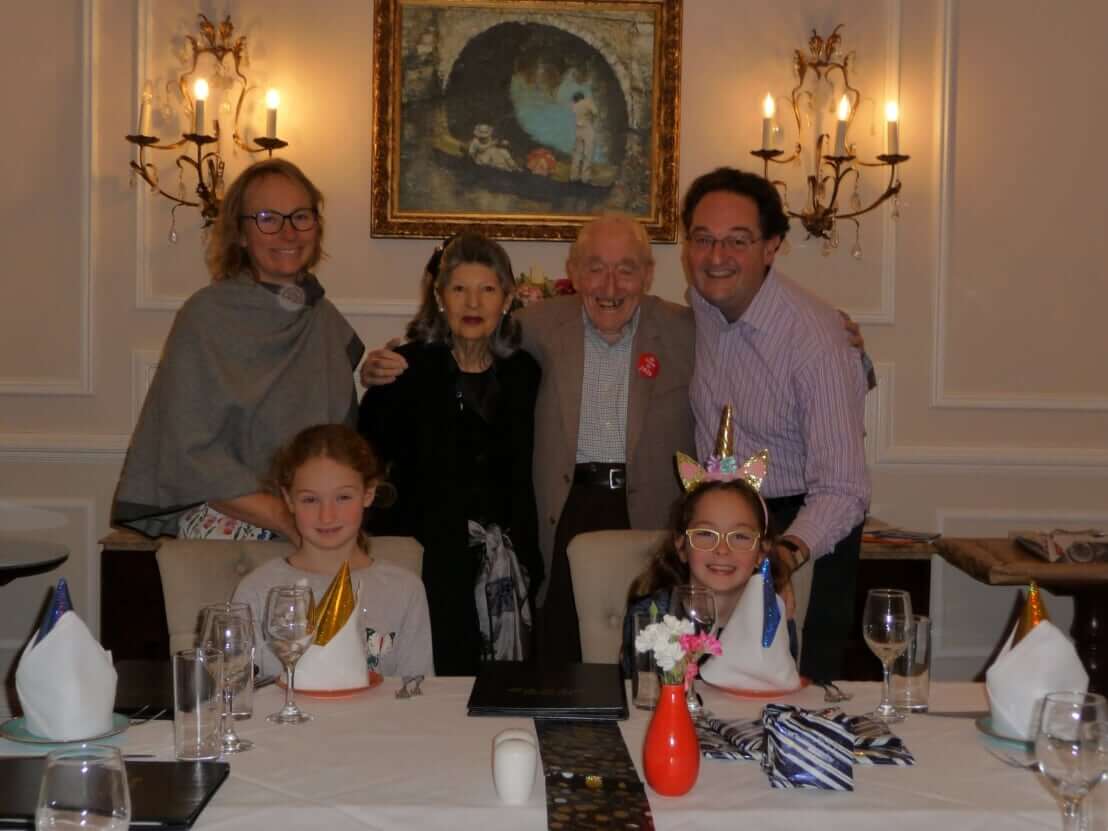
Henry Jackson celebrated his 90th birthday last year at the school’s former Hammersmith premises (now a hotel) with his family
John R Jevons (1943-45), 1928-2020
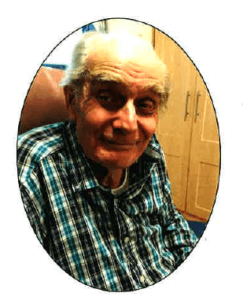
John Jevons was born on the 20th September 1928 in Blackheath, the only child of composer and organist Reginald Jevons, and his wife Elsie.
While still a schoolboy at St Paul’s School in the early 1940s John began working in the summer holidays of 1945 as stage manager for Greta Douglas at the Chanticleer Theatre Club, one of the early London fringe theatres, and in 1946 at the New Lindsey Theatre Club with Peter Cotes, the original director of ‘The Mousetrap’. Peter and his actress wife Joan Miller became John’s life-long friends. He worked with them at several other pioneering fringe venues, which as member only clubs were able to circumvent the authority and censorship of the Lord Chamberlain. Queen Mary famously attended a matinee performance at the New Lindsey of a play entitled ‘Pick-Up Girl, which dealt with the then taboo subjects of juvenile sex, delinquency, venereal disease and child-abuse. The Queen’s attendance served to overturn the censorship which had previously precluded the play’s transfer to the West End.
Post war John underwent training in telegraphic communication, before spending his National Service from 1946 to 1949 serving with the Royal Signals Corps in locations throughout the UK and latterly Germany, where he became an announcer with the British Forces Network.
In 1949 John trained for three years in Speech, English and Dramatic Art at the Royal Academy of Music studying under Rose Bruford, later pioneer of the first acting degree in 1976. An extraordinarily varied, prolific and successful 40 year career in the Theatre followed, as a theatre manager, producer, teacher and actor, working in landmark West End and provincial theatres throughout the UK. In the mid- seventies John worked for two years as manager at St. Martin’s Theatre, where ‘The Mousetrap’ was then 33 years into its world record breaking run. John’s theatre career was interspersed with TV and film work, including memorable cameo appearances as both President George H.W. Bush and Colonel Oliver North on the Rory Bremer Show in 1991, helped in part by his impressive height and stature. John also played many clergymen and professors. Early in his career he worked for a period in the USA, playing juvenile leads at the Barn Theatre Niagara Falls.
In 1954 John took a break from the theatre to work as a maritime radio officer with Marconi on a series of ships. Assignments included working in Newfoundland and Labrador, Canada’s most easterly province, on the DEW (Distant Early Warning) Defence Line, a network of radar surveillance stations established to give early warning of aircraft or missile attack by the Soviet Union during the Cold War.
In 1964 John began a long association with the Trinity College of Music as an examiner of spoken English and Drama, where he worked once more with Greta Douglas, Senior Examiner of the College, whom he had first met as a schoolboy in 1945 at the Chanticleer Theatre. He examined and adjudicated in schools and colleges throughout the world over a 40 year period. In 1980 John was awarded a Diploma of Higher Education and BA in Humanities after attending a three year degree course at Middlesex Polytechnic. John lived for almost 50 years in Crane Court, within walking distance of the West End and Theatreland, close to historic Fleet Street and the home of writer Samuel Johnson. John regularly entertained a wide and eclectic circle of friends, including the late Gretchen Franklin, latterly famous as Ethel Skinner in Eastenders. John met her for the first time in 1969 when she co-starred in a West End production of J.B.Priestley’s ‘When We Are Married’ for which John was theatre house manager. John once recalled, “Gretchen came with Peggy Mount, the play’s biggest star, for a meal here at my home. Frank Thornton (who played Captain Peacock in ‘Are you Being Served?’), was in the same production”.
In the mid-seventies John met his life partner, Tom Whittaker, at famous gay nightclub Mandy’s. John sailed through older age, never looking remotely like his true age. In his mid-80s he became increasingly reliant on Tom for his care and well-being. Celebrating his 90th Birthday he held court to all his closest friends. John died on 5th January 2020 at St George’s Hospital aged 91. A reference found after his death describes John as ‘Meticulous in habit and most careful in detail and manner. Efficient, honest, straightforward, capable and willing’. Although this accurately describes one side of his character, John was so much more than this, having led such a varied and interesting life, touching so many people throughout the world. Possessing a great capacity for fun, friendship, wit and entertainment, he was much loved and admired. Charming everyone he encountered, he was one of life’s true gentlemen, right to the very end.
Written by: Robert Owen, friend
C. M. (Michael) Kauffmann (1943-48)
1931 – 2023
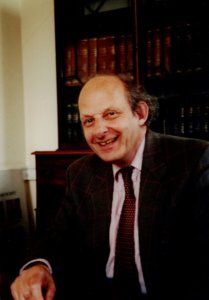
My father’s route to St Paul’s was a roundabout one. He was born in 1931 in Frankfurt, where his father worked as an art auctioneer. The family was Jewish, and in 1938 Michael was sent to stay with relatives in Lancashire. His parents followed, and the family became proud British citizens. He went to schools locally before moving to St Paul’s, then in its wartime exile.
Considering Michael’s later interests, it is notable that the school at this time possessed two medievalists, Philip Whitting (who in class would produce Byzantine coins from his pocket) and the High Master Walter Oakeshott. But the conversation with Oakeshott which Michael always remembered was not about the Middle Ages. One day he was called to see the High Master and was asked why he had failed to report a conversation in which a friend told him that he was feeling suicidal. Michael, sympathetic but calm and resilient by nature, replied that he had never imagined his friend’s feelings would lead to action. Fortunately, the boy had survived the attempt.
After National Service, Michael arrived at Merton College in Oxford in 1950 to read History. There he met Dorothea Hill, who shared his background and was studying Classics at Lady Margaret Hall. They married in 1954 and had two sons, Francis and Martin, who both became Paulines.
On graduating Michael pursued his doctoral studies in Medieval Art History at the Warburg Institute, and then became a museum curator. He soon moved to the Victoria and Albert Museum as Curator of Paintings, whilst continuing to publish on medieval manuscripts. Somewhat to his surprise, in 1985 he was appointed Director of the Courtauld Institute, a new challenge which involved moving the Institute from Portman Square to Somerset House in The Strand.
In retirement, Michael nursed Dorothy until her death and went on writing and teaching until well into his eighties. He served several institutions with loyalty and dedication, but always remained completely himself: the memorable giggle burst out as much at work as it did at home.
Martin Kauffmann (1975-79), son
Peter J Kennett (1944–48) (previously know as Peter J Kovacs)
26th May 1930 – 29th December 2022
Known as Peter Kovacs at St Paul’s, he was born in Berlin, before moving to London in 1935 when his parents realised that life in Germany was becoming too difficult. They settled in Hampstead, with Peter attending the Hall School, and then gaining a scholarship to St Paul’s.
He loved his time at SPS, representing the school at rowing and was very active in the debating society (a passion for political debate he maintained through his lifetime); he also recounted with pleasure of the days cycling to and from classes while evacuated in Crowthorne. But it was the love of history and politics where SPS left its strongest mark. The inspiring lessons from Phillip Whiting and the discussions in the History VIIIth, created a lifelong interest (and resulting library) that Peter held to his final days.
After military service with the Royal Logistics Corp and a change of family name, Peter studied Economics, Politics and History at the LSE, where he was Captain of Boats. In his final student days, he met Christine Minns at a boat club event, and after qualifying as a chartered accountant, proposed marriage. 65 years of happy marriage and three children ensued. A fourth child died, a few months old.
Peter initially worked as a management accountant at Ford, and then as an analyst at various stock brokers and merchant banks, specialising in the valuation of property funds. In 1972 he set up PJ Kennett & Co Ltd, to identify and initiate corporate mergers between West German and British companies. He ran this for 30 years, funding school fees, opera tickets and the other pleasures of life.
Peter and Christine and the three children, Nicholas, Roland and Miranda, lived a vibrant life in Highgate. Along with the family, Peter’s great love was live opera and theatre. He was very knowledgeable, with an extensive library of books, programmes and recordings. From 1947 to 2018 he saw every opera production performed at Covent Garden, many twice to focus on different aspects. He would then debate the production at length. In retirement Peter and Christine would travel around Europe and the US to attend the latest productions.
He shared his love of theatre and opera with his children from an early age.
Peter’s was a life well led; a life of strong and lifelong interests and views that he shared until his final days, with excitement, joy and passion. He died after a short illness.
Written by: Nick Kennett (1973-78)
Stephen King (1937-42), 1923-2018
Stephen King was born on 11 September 1923, the younger son of Ernest William King, a solicitor, and his Scottish wife, Janet Patterson Struthers. The family lived in Bedford Park, West London, and both Stephen and his elder brother Alan (born in 1922) started their education first at a PNEU school in Richmond and then at Gunnersbury Prep School in Chiswick. Here Stephen formed a liking for maths, greatly encouraged by one of the masters, Mr. E.A.W. Rogers, who also taught him to play chess; in 1933, he won not only the Junior Chess prize but also the Junior Gym Cup.
The family fell upon hard times during the 1930’s so when in 1937 Stephen won a Junior Foundation Scholarship to St. Paul’s School, it was a relief for his parents: the school fees of £45 per annum were cancelled. Gunnersbury School too had reason to give thanks: they were awarded a half day holiday to celebrate the award. It was just about that time too that, for financial reasons, Stephen was sent to live with his grandmother at 53 Talgarth Road, West Kensington, from where he could walk to St Paul’s School at the end of the road.
Stephen started life at St. Paul’s in the Autumn Term 1937 in the Remove, where all the boys were foundation scholars and where they were taught Latin, Greek, French, Maths, a modicum of science, art and general studies. Stephen wrote:
“Maths was still my great love as much as a schoolboy can love schoolwork and this was encouraged by a splendid maths teacher, Mr. F.G. Bird, though I was quite happy with all my teachers; I suppose encouragement, not threats, was the way they dealt with us and expected and got interest if not always understanding in what they were trying to teach us”.
By 1938, and certainly by the Munich crisis, he and his brother Alan were living at home again but not for long. In the autumn of 1939 the School evacuated to the Mansion at Easthampstead Park in Berkshire, a few miles from Bracknell and this meant that in term time all the boys had to be billeted in private homes nearby.
Both King boys were billeted on Mr. & Mrs. F. G Keys at 1, New Houses, Easthampstead; Mr. Keyes was chauffeur to Lord Downshire, (“Lordy” to Mr. Keys), the owner of Easthampstead Park. “Mrs. Keys came from Forfar and was most adept at making the wartime rations eke out and treated me and my brother like her own two sons Freddy, a year or so older than me and Richard, younger; there was also the cocker spaniel Betty; her two daughters were away, Jean a nurse and the eldest, Elizabeth, I think possibly in the forces.”
By this time Stephen was in the Lower Eighth Form studying classics, despite his preference for maths. Later he admitted that what he would really have liked to have done was physics; he was undoubtedly a polymath. He had done nearly as well at the end of his time in the Remove in Classics as in Maths and his parents thought a classical education was the better; Mr. Bird would have preferred him to have ‘gone mathematical’. Boys who had gone into the Lower Eighth to study Classics did not bother to sit the School Certificate Exam as the aim was to take the Higher School Certificate while in the Upper Eighth. This he did successfully in July 1941 in Classics with a subsidiary subject of English Literature.
During the school holidays both boys cycled home to London, a journey of about 25 miles, returning the same way to Easthampstead at the beginning of term. Stephen wrote that “I well remember watching the vapour trails of the aircraft during the Battle of Britain though of course we had no idea of the importance of what we were watching.”
As soon as he reached the age of 17, Stephen joined the Local Defence Volunteers (later renamed the Home Guard). This gave him a cash subsistence allowance, as he was paid for night duty, so he had some regular income, the first since his pocket money allowance of 1d per school-day at Gunnersbury! He had existed until then by using Christmas and birthday presents from uncles and his grandmother.
In December 1941, he went to Cambridge to take the scholarship exam at Magdalene College; everyone in his form, then the Upper Eighth, went to take the exams at a College either in Oxford or Cambridge. Those who preferred a particular College opted for that one but otherwise they took the advice of their schoolmasters, at that time (for Stephen) they were George Ewart Bean, who taught Greek, and Leslie Matthews, teacher of Latin. The object was for no one to compete against a form mate. Stephen was fortunate to be awarded an open Exhibition in Classics at Magdalene College.
He then had to decide as to whether he should go up straight away, with the possibility that he would be called up for military service before he had taken any exam as part of a degree (Classics was not a subject which gave automatic exemption), or whether he should postpone the whole thing until the war was over. As usual, finance, or the lack of it, made the decision. Some of his form mates decided to go up and got exemption but Stephen, ever a forward-planner, worked out that his age group would be called up before the end of the summer term, thus ensuring that he would avoid the end of term ordinary school exams. He wrote:
“I just made it as I was called up on the 2nd July 1942. This was just as well as I had scamped a proper reading of the set books and had I been entered for a second go at the Higher School Certificate in the hope of gaining a distinction, I should almost certainly not even got a pass.”
Written by: Margaret King, widow
Lt Col David A Lloyd (1943-46), 1928-2020
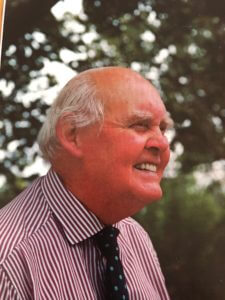
David was born in Cairo, Egypt on 13th December 1928 and attended St Pauls between 1943 – 1946. He was evacuated to Wellington College in Crowthorne, Berkshire. While there, David was placed in Normanhurst, under Charles Lillingston (Head of History), whom he much admired. The School returned to London in 1946, but David was only there one term before joining the Army.
He was commissioned in to the Royal Artillery in October 1948. He spent 6 years at regimental duty, but he also found time to represent the Old Paulines at rugby and toured with them on their Easter trips to the West Country. One of his early regimental tours included a spell in Korea and Bill Godfrey (an Old Pauline) was posted to the same sub unit. David then returned to the UK in December 1953 to complete a Pilot’s course in Middle Wallop. Also on the course was another Old Pauline, Michael Mather. He spent the next 28 years fluctuating between Instructor’s appointments and tours at regimental duty, eventually retiring from the Army in December 1978.
After two Civil Service appointments, he was selected to be the Appeals Director with the Treloar Trust, which supported the Lord Mayor Treloar College at Alton. He completely immersed himself in to this role and loved it.
Full retirement saw him taking an active role with the Friends of Arundel Castle Cricket Club and Boxgrove Priory. He was extremely committed to the Priory and he loved his time worshipping there. He made many friends and until recently was always offering himself up to read the lesson. He simply adored the Priory and enthusiastically attended Services at least twice a week.
David married Anne in November 1954; they had 3 children, Simon, Christopher and Caroline. Both Anne and Christopher (Kippa) predeceased David. He is hugely missed by his two children, 5 grandchildren and all his family and friends. He passed away on 12th May 2020.
Written by: David’s family
Robin (Mac) Macdonald (1943-48), 1929-2018
Robin died in April 2018 aged 88.
He was born in Dulwich, the brother of three older sisters, and went first to Dulwich College Prep School and then on to St Paul’s in the early 1940s, evacuated away from the war to boarding accommodation in Crowthorne in Berkshire.
In that part of Berkshire every highway and byway was lined at 25 yards with small, open corrugated iron roofed huts, stuffed with ammunition and boxed armaments, all initially ready for the defence against the German invasion and subsequently for the invasion of Europe by the Canadian army, which was heavily located around Crowthorne for the Newhaven/Dieppe raid.
The huts existed for the investigative delight of Mac and some others among the several hundred student Paulines, who cycled the daily three or four miles, in all weathers, for schooling, to the Victorian mansion Easthampstead, then back, and then onward again to games grounds borrowed from adjacent Wellington College for rugby and cricket.
Boxing made the boys incredibly fit and well tutored by boxing coach and champion Irishman Begley, and the chemistry master, Bow Langham – the war office military Army, Navy and Air Force declined boxing matches with the school, saying that it was not good for military morale to always be beaten by schoolboys – we compromised by offering some of our second string boxers, alas with no losing effect. Mac boxed on.
One of the trophies among Mac’s wartime acquisitions was a Luger pistol. It had a fault in that it did not automatically recock when fired, and in that state seemingly was just a symbolic deactivated pistol. This saved the day for Mac when he was hauled in front of the High Man having been reported by a groundsman for allegedly shooting not at, but through the wooden Cricket Pavilion. The High Man, Oakshott, the quintessential academic, knew a bit about firearms it turned out, and on examination said it was “inert” and handed it back to Mac ….unpunished, but saying “don’t go showing it abound”.
So began Mac’s involvement, aged 14, and lifelong interest and support for pistol shooting, and in 1947 the establishment of shooting as a sports activity at St Paul’s.
Added to that there followed many Bisley National and International competitions, with a raft of trophies, and establishing the activity as a sport for paraplegics. And finally for the future, ultra safe, with no bullets: Laser Shooting.
Additionally he was a busy supporter of G Club in the school, often volunteering for the sports he was not particularly good at …. for the sheer fun of being involved.
Leaving school, National Service saw Sergeant Mac in the Military Police, serving in N. Ireland and London among other places. On one occasion visiting an “out of bounds” establishment in occupied Germany, he met up with three uniformed national service Old Pauline soldiers sitting in a back room. Without missing a beat on recognising them, he closed the door on the police detail he was leading, pointed to a back door and bellowed “OUT! You lot. On the double!”
With their whit spats, truncheons and helmets, a sight not to be messed with!
The miscreants scrambled out while he opened the door behind him he had closed, and explained, as the sergeant in charge, that he did not want his fellow Military Policemen clearing up some imagined mess in their “paddy waggons” or black Marias. Indicating the out of bounds law breakers he had thrown out were not worth corralling.
One of the three “out of bounds” soldiers was a school friend, Patrick Bashford, who ruefully laughed off the incident 30 years or so later at a school lunch, where Patrick was then working as a teacher …. of the guitar.
As a wartime evacuee to Crowthorne, Mac lived with 25 or so others at Assistant High Man A B Cook’s Barracane House, and as with most of the very different students, Cook seemed to collect into his house, they stayed in contact long after leaving St Paul’s, using Mac’s invented wartime prefix “Boss” Cook in an affectionate manner, when referring to him. Get-togethers were at Miss and A B Cook’s house in Barnet, decades later. Some, having become conventional captains of industry, academia or medicine, were often startled by Mac’s use of the title instead of the more ordinary deferential “sir”, or even his name, Alan, who, in turn, was not perturbed by the perceived lack of convention.
In an unusual way, Mac’s “Boss” Cook, at Barracane, was a distant, informal surrogate father and a big influence for Mac and many others of us who lived there. Particularly those who seemed to attract trouble, if only by being different and subsequently in need of advice.
At school, and in his later life, Mac was a non-conformist and individualist. Both well recorded Pauline attributes, and markers for the life he enjoyed.
Written by: Seamus Flannery (1942-47), friend and Madeline Macdonald, widow
Clive M Moss (1944-48)
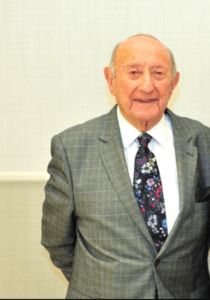
Clive Moss started his education at Colet Court before moving to New York at the outbreak of war, returning to the Hall School and eventually to St Paul’s where he was both a junior and senior scholar.
Evacuated to Crowthorne, Berkshire, he spoke fondly of his time at the School and in particular the stewardship of the Highmaster, Walter Oakeshott, and the inspiring history lessons taught by Philip Whitting in the ‘History Eighth’.
Clive was articled at Lord Foster in King William Street in the City where he qualified as a Chartered Accountant. He then spent his career in private practice in the West End around the corner from Portland Place where he grew up as the son of a doctor, Louis, whose local surgery treated the stars of the West End shows.
Clive had a passion for silver and became a renowned expert in Victorian silver vesta cases, contributing to articles and books on the subject. He was a familiar figure in London’s antiques markets, in particular, Portobello Road. During his retirement, he became Treasurer of The Friends of Kenwood House in Highgate, a short distance from his home. He enjoyed travelling abroad, near and far.
He was married for over 60 years to Anne whose brother, Jack, was also at St Paul’s at the same time. Up to his death, Clive enjoyed the close friendship of several Old Paulines and was a devoted and very proud husband, father to children, Alexandra, Juliet and Jonathan (OP 1983 to 1987), grandfather and great grandfather. Previously in good health, Clive died from Covid-19 in a matter of hours in hospital on 24 March.
Written by: Jonathan Moss (1983-87)
Michael Oliver
(1946-47)
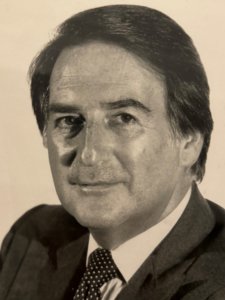
Michael Oliver was born in Cricklewood, North London. He was sent to the Lake District during the war and later went on to Oundle School. He returned to London and then attended St Paul’s. He was very happy there and always said that the teachers treated the pupils as adults. A welcome change. He decided to go into law and took his articles with a law firm in London. He later, with a law partner, started his own practice, Berger Oliver, in Piccadilly. He specialised in copyright and contract law and quickly amassed an enviable client list from the entertainment industry with many A-list actors, pop singers, directors, choreographers and impresarios. He sat on the board of the National Youth Theatre and LAMDA for many years.
In 1982 after sitting the California Bar exam, he moved to Los Angeles, something he had always wanted to do, where he continued to practice, taking a brief hiatus to become a vice president at ICM, then one of the world’s largest talent agencies. Whilst there, he co-founded BAFTA LA which has become an enormously successful part of BAFTA. In 1991, he returned to London and became the chairman of a Westminster law firm. He was also invited to join the board of the Royal National Theatre where he served two terms.
Retiring in 1998, he moved to Umbria in Italy, a country, a people and a language that he loved. He lived a life there very different from all the star-studded years that had gone before.
He died peacefully at home one week short of his 93rd birthday. He is survived by his civil partner of 45 years.
Jeremy Poole, civil partner
Peter H Rothschild OBE (1937 – 1940)
Peter was born in 1924 in Freiburg, Germany. In 1928 he came to the UK when his father took up an academic post at Cambridge. Returning to Germany in 1932 the environment for a Jewish family was already difficult and friends they had made in England arranged for them to come back permanently. He went to The Hall and then St Paul’s, initially at West Kensington and then at Crowthorne. He matriculated in 1940 and we still have the heavily censored copy of Jane’s Fighting Ships that he was awarded at Apposition for Geography.
He worked briefly for London Transport before joining the Kings Royal Rifle Corps. He was demobbed as a captain in 1947, having served a stint with BAOR. He then collected a degree in Economics from the LSE before re-joining London Transport. His remaining career was all within the transport field.
His life was marked by endless enthusiasm for his passions. He maintained his ties with his Old Pauline friends right to the end. He served with the KRRC in the TA until he had to retire but he and Lord Bramall still exchanged birthday greetings until their last. In his retirement he remained remarkably active, working as a police volunteer, a driving force within the British Chambers of Commerce in Europe, a Rotarian and as a director of the Romney, Hythe and Dymchurch railway.
In 2008 he was awarded an OBE in respect of his services to trade. Up until months before his death he was still going, probably the oldest police volunteer in the country, still an active Rotarian and proud to witness the 90th anniversary of his beloved railway.
On Febuary 14th 1944 Peter met his future wife, Helen, a corporal in the Royal Canadian Air Force, on a blind date. They married in 1948. Helen and their two children Mary and David (also an OP) all survive him.
Written by: David Rothschild OP (1964-69), son
Leslie Rubinstein MBE (1941-45), 1928-2021
Leslie Rubinstein MBE died on December 30, 2021, at his home near Montpellier, France, following a short illness. He was survived by Helena, his wife of 66 years, and by his daughter Diane and family.
Leslie was born in London, on June 14, 1928. After his family was evacuated during the war, he attended St Paul’s as a scholarship student from 1941 to 1945, billeting at Crowthorne and attending classes at Easthampstead Park. He had fond memories of his time at St Paul’s.
After the war, Leslie worked in the family business, while pursuing interests in motorcycles and the clarinet, until a double date where he met a Finnish woman, Hanna Helena Jämsen, then working at the London Hospital for Tropical Diseases. It was love at first sight.
They left for Stockholm, where they married in 1955. Leslie spent a few years in industry and then became a commercial attaché at the British Embassy. Their daughter was born in 1961. The family remained in Sweden through the 1960s and relocated to Copenhagen in 1971, with Leslie still at the British Embassy, receiving an MBE for services to industry in 1977, and Helena at the South African Embassy. They were a popular couple, hosting parties for an expanding international group of friends and co-workers.
In 1982 they sought some relief from the cold and moved to the South of France, buying land in a village near the sea. Leslie continued to work, as an English teacher at the Chamber of Commerce and translator, but there was time enough for beaches, saxophone lessons, and trips to Japan and later England to visit Diane and her growing family.
Leslie and Helena remained happily together in the home they built, where Leslie passed away at the end of 2021. Helena followed not long after, on 4 March, 2022. Leslie and Helena are hugely missed by their daughter and son-in-law and three grandchildren, Alice, Georgia, and Joseph.
Written by: Diane Clothier, daughter
Geoffrey J Sadow (1944-49)
Geoffrey Sadow was born in Cricklewood in 1930, the only child of accountant Alexander Sadow, and his wife Anne. At the age of 7, a freak accident playing football at school led to septicaemia and bone infection which plagued him throughout his life. There were no antibiotics and the only treatment was surgical drainage and complete bedrest. Numerous operations meant he missed 5 years of school, however he still managed to get into St Paul’s in 1944. Despite his profound limp, he learned to ride a bike which meant he could attend some lessons on another site! Tragically, later that year, when he was just 13, his father died following surgery for cancer.
He went on to study medicine at University College Hospital and became a Fellow of the Royal College of Surgeons. He worked at a number of NHS hospitals, eventually becoming Orthopaedic Consultant at the Royal Victoria Hospital in Kingston. He also worked in private practice in Harley Street. He was devoted to his patients and received many letters of thanks from those who lives he had improved. After retirement he often served as expert witness in clinical malpractice cases.
He had a passion for classical music, horse racing, fine wine and antique clocks. He combined his passion for horse racing with acting as consultant in cases of jockey injury. He attended many classical concerts and race meetings with his wife Daphne, with whom he shared a love for the Jewish way of life and their Synagogue community. They were supporters of the Yehudi Menuhin School for young musicians. They travelled extensively.
He was very proud of being an Old Pauline. As well as making a significant contribution through his successful career in orthopaedics, his legacy includes triumph over adversity. He lived with constant pain from that childhood injury, but seldom complained about it.
He is survived by his daughter, stepdaughter and grandchildren.
Written by: Geoffrey’s Family
John N Suggit (1935-41), 1922-2023
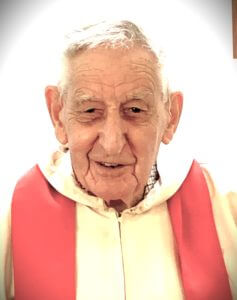
John recalled his first days in St Paul’s Great Hall; the mosaics of Colet and Erasmus and the stained-glass windows featuring former pupils, including John Milton. He was a studious boy, mastering Greek and Latin. This earned him scholarships and set a path for his life.
The daily commute from Norbiton to West Kensington ended in 1939, when the school was evacuated to a country house Easthampstead Park in Berkshire, pupils cycling to their new base. One night he was on OTC bicycle patrol, spotting hostile paratroopers, when a bomb landed nearby. They learned that it had hit the Headmaster of Wellington College where Science lessons were held.
John won an open scholarship to Oxford, but National Service scuppered that plan. Six weeks into training at Bovington Camp, he was on a motorbike escorting a convoy when he crashed and smashed his head. Protected only by a beret, he was in a coma for weeks and doctors prepared him for the worst. After over a year of convalescence, he was discharged as permanently unfit. Against the odds, he took up his place at Oxford, following ‘Greats’ with Theology as his mind turned to a life of Christian ministry.
He married at the end of the war, moved to South Africa ‘for a short period’, was ordained and remained there till his death. He felt that he had a calling to make a difference as a minister, academic and theologian in this complex society. His multiple titles and post-nominals would fill an envelope or formal document, causing some hilarity for us, his children.
He was a parish priest in Port Elizabeth and then Archdeacon in Queenstown before becoming Warden of St Paul’s Theological College in Grahamstown, the training college for all Anglican clergy, where he was also Chancellor of the Cathedral. He was appointed to Rhodes University as Professor of New Testament Studies and then as Dean of Divinity. He once successfully argued that the Nationalist Anthem, Die Stem, should not be sung at university events, and then composed the words for a university song to be sung at formal events, in Latin, of course.
His students called him ‘Phronimos’, from the Greek meaning ‘practically wise’ and it was as a theologian that he was so respected, interpreting the meaning of the Bible in a changing society, challenging established dogma. He gained a reputation as a leading theologian across all denominations in South Africa. His stand against the Apartheid system did not always make him popular with the ultra conservative Afrikaner Reformed Church but he did command respect and they made him an honorary life member of the New Testament Society of South Africa on his retirement.
He retired to Cape Town when he was 68 but remained active in local ministry, was a visiting lecturer at various universities and became a prolific writer of esoteric Theological books until his late 90s.
As a humble man, he was overawed by the accolades from ex-students, clergy, bishops and family at his 100th birthday – his mind undimmed by age.
Written by: Nicholas Suggit, son
John L Thorn
(1939-1943)
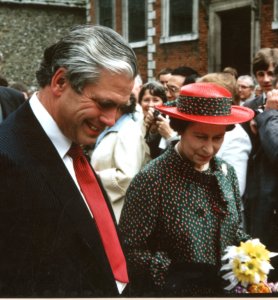
In 1968, when student riots swept across Europe, John Thorn was rumbling his own revolution in the cloisters of Winchester College.
Thorn championed the ballads of Bob Dylan and permitted the boys to grow their hair; he reduced compulsory attendance at chapel; he turned the gym into a theatre and the sanatorium into an art school. He fostered science as a subject, channelled money into arts scholarships and shocked the board by selling the school’s original manuscript of Malory’s Le Morte d’Arthur to the British Library to pay for state school bursaries.
Thorn raised the status of opera and classical music at the school. A performance of Beethoven’s Fidelio summed up his philosophy of education: the championing of freedom over despotism.
Winchester’s music school became one of the finest in Britain. As a director of the Royal Opera House, Thorn invited pupils to join him and his wife, Veronica, in the royal box. He combined his liberalism with “small c” conservatism; defending independent schools and their charitable status: “Abolish the independent schools and you abolish some of the riches of civilisation,” he said.
John Thorn was born in Chiswick in 1925. His parents, a railway clerk and a librarian, encouraged their son to aspire in life; Thorn won a scholarship to St Paul’s. Before taking up a second scholarship to Corpus Christi College, Cambridge, he served for two years from 1943 in the destroyer HMS Eskimo, sweeping for German E-boats.
After completing a first in the history tripos, Thorn became head of history at Bristol. At 36, he was appointed headmaster of Repton in Derbyshire. His yearning for social change and the reforms he began to introduce, such as abolishing corporal punishment, angered traditionalists. He moved on to become headmaster of Winchester, where he taught a full timetable and wrote textbooks. In retirement Thorn taught liberal humanist subjects; he was trustee of the British Museum and a governor of three schools.
Thorn’s wife Veronica died in 1999; John Thorn died in October 2023, aged 98, and is survived by their son and daughter.
Adapted from the obituary published in The Times on 13 November 2023
Richard (Dick) Wilson (1939-43), 1926-2018
WILSON, Richard “Dick”, Mallinckrodt Professor of Physics Emeritus at Harvard University, died on May 19, 2018, in Needham, Massachusetts. Dick will be remembered for his scientific work, student mentorship, principled humanitarian and environmental stands, and interdisciplinary connections across the globe. Dick was also a railway enthusiast, Morris dancer, concertina player, world traveler and hiker.
Dick was born in Putney, London, the youngest of four boys to Percy, a civil servant, and Dorothy (née Kingston), a teacher. All four went to Colet Court and became Foundation Scholars at St Paul’s. They all joined Scout Troop I (13th Hammersmith). He, his brother Geoffrey, and two other boys from Troop I, Bill and Dick Stock, bicycled to Crowthorne on August 31, 1939, the day before the official school evacuation. They were billeted at Alderbrook, where the billiard room became the dormitory for eight boys. Dick had been described as “you silly Mugwump” by Chris Heath, Scoutmaster, at the troop’s summer camp in August 1939 at Launceston, and to avoid confusion among three Richards Dick became known by the nickname Wump.
In 1943 Dick was awarded an Open Entrance Scholarship to Christ Church College, Oxford. In his first year he read Mathematics with Theodore Chaundy as his tutor. He then switched to Physics and earned his BA in 1945 and his DPhil and MA in 1949. He was awarded a Guggenheim Fellowship for post-doctoral work in the U.S. at Rochester University and then at Stanford University with Wolfgang “Pief” Panofsky. While at Stanford, Dick met Andrée Désirée DuMond, marrying her in January 1952 after a brief courtship. In 1952, they moved to Oxford University for Dick’s research lecturer position, and in 1955 to Cambridge, Massachusetts, for Dick’s faculty position at Harvard.
Dick specialized in experimental particle physics, studying the nature of the smallest particles that constitute matter, as they collide at very high velocities. Dick led the upgrade of Harvard’s proton cyclotron to 160 MeV in order to study nucleon-nucleon interactions. With Harvard and MIT colleagues, Dick designed, constructed, and used the Cambridge Electron Accelerator (CEA) 6 GeV synchrotron, which, from 1962 on, further probed nucleonic structure. Dick was involved in constructing and using the new Fermi National Accelerator Laboratory (Fermilab) in Batavia, Illinois, frequently “commuting” there from Harvard, to maintain close contact with students and research. At Fermilab, Dick continued the study of nucleonic structure with high-energy muon beams. When Harvard’s cyclotron became obsolete for particle research, Dick helped adapt it for the treatment of cancerous tumors. He also studied electron-positron interactions with the CLEO collaboration at the Cornell Electron Storage Ring (CESR). Finally, Dick joined a research group using the intense polarized beam of the new Continuous Electron Beam Accelerator Facility (CEBAF) in Virginia.
Dick went often to the USSR and Russia, believing that direct cultural and scientific contact was essential to prevent war. After the exile of dissident Soviet physicists, Dick boycotted USSR conferences, and was an early and visible supporter of Andrei Sakharov. Dick studied nuclear power safety and environmental carcinogens, such as asbestos. He visited Chernobyl after the nuclear accident, taking a PBS film crew with him. He studied arsenic in drinking water, and was especially proud of starting a program to provide safe arsenic-free water from a village-well in Bangladesh. See more in the obituary in The Guardian of 3 June 2018 at:
https://www.theguardian.com/science/2018/jun/03/richard-wilson-obituary
Dick authoured 935 scholarly papers and eight books, including, finally, a memoir Physics Is Fun: Memoirs of a Life in Physics (2011).
Dick remained devoted to Andrée. They lived in Newton, MA for over 50 years, where Andrée created an extraordinary garden retreat. They loved hiking and climbing mountains, often with their children. Dick loved to sing, recalling countless traditional British folk and music hall songs, and often accompanying himself on the concertina. His Harvard Physics Laboratory photo showed him dancing the Fools Jig with the Headington Quarry Morris Men in Oxford. Dick is survived by his brother Geoffrey, his sisters-in-law Alison Wilson and Adèle Panofsky, and by his six children and their partners, A. Christopher (Rita McMahon), Michael (Lisa Greenleaf), Nicholas (Carol Anne Freeman), Elaine (Brad Farnsworth), André A. (Mary Frances Bond), Peter (Julie Whitmore); and three grandchildren, Benjamin Farnsworth, Irene Farnsworth (Matt Solimano) and Tyrone Whitmore-Wilson. He was predeceased by his wife Andrée Désirée, and his brothers Arthur and Laurence. He is fondly remembered by devoted caregiver Mrs. Bethune Labeach, extended family, and his many students, colleagues, and friends.
Written by: Geoffrey Wilson, brother, and Elaine Farnsworth, daughter
Anthony J Winner (1945-49)
Anthony Winner, who has died aged 88, had three different careers and loved them all. After he qualified as a chartered accountant his father fell ill, so he began running the family firm, the Gift Coupon Company (rivals to Green Shield Stamps). From there he moved into retail and took over a chain of London shoe shops. (One, in Leather Lane, appeared in the Paul Newman thriller The Mackintosh Man after Anthony lent Newman his office there).
Later, Anthony switched to life insurance, where he flourished by being honest and ethical in a business then notorious for hard-selling chancers. Cleaning up the industry became a mission, and, in later roles with the Life Insurance Association, he influenced what became successive Financial Services acts. He also realised, with the Helm Godfrey partnership, his long-term dream of creating a practice to unite financial specialists of all kinds under one roof. When he retired, his gala farewell dinner at the Drapers’ Hall testified to the respect he earned in the industry.
At school he’d boxed, played bridge, founded a football club, and invented a version of cricket played entirely with pencils. When I was little, my friends used to come to the house to ask if he could come out to play. I could come too, but, with his warmth, skill and sense of fun, he was the main attraction. Later, he became a fine amateur football referee, all-London bridge champion, and a leading member of the Acol Bridge Club, where a tournament now bears his name. He took up distance running in his late forties and, in his fifties, ran two London marathons and one in New York. He built a unique collection of stamps from imperial-era Malaya and was a key figure in the Jewish Genealogical Society.
He was blissfully married for 66 years to Monica, an artist, and had three children, four grandchildren and two great grandchildren.
Written by: David Winner (1970-74)